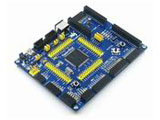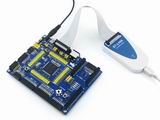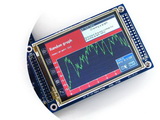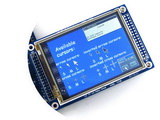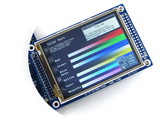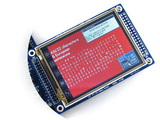Open103Z Standard Open103Z Standard, STM32F1 Development Board
- Mã sản phẩm: Open103Z Standard
- Nhà sản xuất: Waveshare
- Website hỗ trợ: https://www.proe.vn
- DESCRIPTION
-
STM32 development board designed for STM32F103Z series, features the STM32F103ZET6 MCU, and integrates various standard interfaces, pretty easy for peripheral expansions.
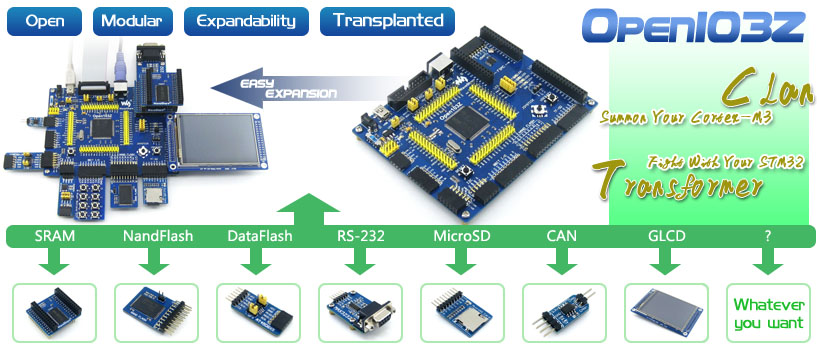
Overview
Open103Z is a STM32 development board that features a STM32F103ZET6 device as the microcontroller. It supports further expansion with various optional accessory boards for specific application. The modular and open design makes it the ideal for starting application development with STM32F family.
Note: Open103Z Standard includes only ONE accessory board -- PL2303 USB UART Board (mini).
What's On Board
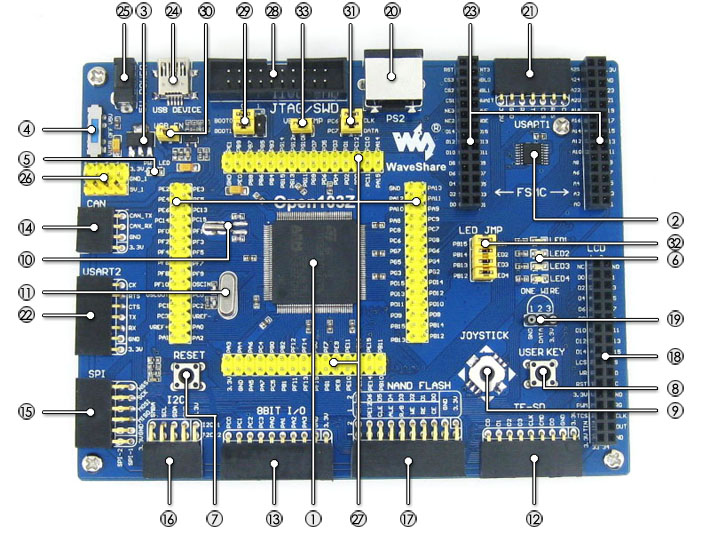
- STM32F103ZET6:the high performance STM32 MCU in LQFP144 package which features
- Core: ARM Cortex-M3 32-bit RISC;
- Operating Frequency: 72MHz, 1.25 DMIPS/MHz;
- I/Os: 112;
- Operating Voltage: 2-3.6V;
- Memories: 512K Flash, 64K RAM (the highest specification in STM32F103Z series);
- Communication Interfaces: 3xSPI, 5xUSART, 2xI2S, 2xI2C, 1xFSMC, 1xLCD, 1xSDIO, 1xUSB, 1xCAN;
- AD & DA converters: 3xAD (12bit, 1μs, shares 21 channels); 2xDA (12bit);
- Debugging/Programming: supports JTAG/SWD (serial wire debug) interfaces, supports IAP;
- 74LVC139: Used for FSMC expansion, makes it possible to connect multi peripherals through FSMC at the same time, such as connecting a LCD and a NAND FLASH;
- AMS1117-3.3: 3.3V voltage regulator;
- Power supply switch: 5V DC or USB;
- Power indicator;
- LEDs: Convenient for indicating I/O status or program debugging running state;
- Reset button;
- User key;
- Joystick: Convenient for I/O input (five positions);
- 32.768K crystal oscillator: for internal RTC;
- 8M crystal oscillator: enables the MCU run at 72M frequency by frequency multiplication;
- SDIO Interface: connects to the Micro SD Board easily, It is much faster to read/write the Micro SD card via SDIO than via SPI;
- 8 I/O Interface: easily connects to keypad, motor, etc;
- CAN Interface: communicates with accessory boards which feature the CAN device conveniently;
- SPI Interface: easily connects to SPI peripherals such as FLASH (AT45DBxx), SD card, MP3, etc;
- I2C Interface: easily connects to I2C peripherals such as I/O expander(PCF8574), EEPROM (AT24Cxx), etc;
- NAND FLASH Interface: easily connects to the NAND FLASH peripherals;
- LCD Interface: easily connects to the touch screen LCD;
- ONE-WIRE Interface: easily connects to ONE-WIRE devices (TO-92 package), such as temperature sensor (DS18B20), electronic registration number (DS2401), etc.
- PS/2 Interface: easily connects to PS/2 keyboard or mouse;
- USART1 Interface: easily connects to RS232, RS485, USB TO 232;
- USART2 Interface: easily connects to RS232, RS485, USB TO 232;
- FSMC Interface: easily connects to FSMC interface, such as NorFlash (S29GL128P), SRAM (IS62WV51216BLL);
- USB Port: USB communication between board and PC;
- 5V DC jack;
- 5V/3.3 V power input/output;
- MCU pins connector: all the MCU pins are accessible on expansion connectors for further expansion;
- JTAG/SWD interface: for debugging/programming;
- Boot Mode Selection: for configuring the BOOT0 and BOOT1 pins;
- USB Enable Jumper
- Short the jumper to enable the PC auto detection while USB connecting;
- Open the jumper to disable;
- PS/2 Interface Jumper
- Short the jumper to connect the PS/2 device to default I/Os;
- Open the jumper to connect the PS/2 device to custom I/Os via DuPont wires;
- LEDs Jumper
- Short the jumper to connect the LEDs to default I/Os;
- Open the jumper to connect the LEDs to custom I/Os via DuPont wires;
- VBAT Selection Jumper
- Short the jumper to use system power supply;
- Open the jumper to connect the VBAT to external power, such as battery;
Photos

Connecting to touch screen LCD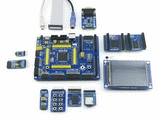
Connecting to various peripherals
Note:
The Open103Z supports programming via STM32 USART bootloader, a USB TO UART accessory board is also provided in the package.
The Open103Z does NOT integrate any debugging function, a debugger is required.
The Open103Z Standard includes only ONE accessory board -- PL2303 USB UART Board (mini).
JTAG/SWD Interfaces
The figure 1, and 2 show the header pinouts of JTAG/SWD interface
Figure 1. JTAG Header Pinout
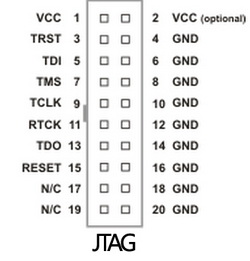
Figure 2. SWD Header Pinout
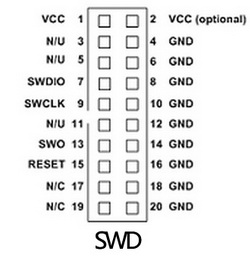
Development Resources
- Related softwares (KEIL etc.)
- Demo Code (examples in C, μC/OS-II)
- Schematic (PDF)
- STM32 Development documents (Datasheet etc.)
- STM32F103ZET6:the high performance STM32 MCU in LQFP144 package which features
- PACKAGE CONTENT
-
Weight: 0.216 kg
- Open103Z development board x 1
- PL2303 USB UART Board (mini) x 1
- USB Cable (mini) x 1
- 4-pin wire x 2
- 2-pin wire x 2
- USB power cable x 1
- Software CD x 1
Điện tử ProE cung cấp linh kiện điện tử, thiết bị điện tử , linh kiện IoT chính hãng. ProE cung cấp dịch vụ đặt hàng linh kiện điện tử, thiết bị điện tử chính hãng theo yêu cầu cụ thể của khách hàng. Liên hệ : contact@proe.vn, SĐT: 0938946849
Website: www.proe.vn
Diễn đàn: https://www.facebook.com/groups/278263459284765/
Youtube Chanel: ProE Youtube
Facebook: ProE Facebook


